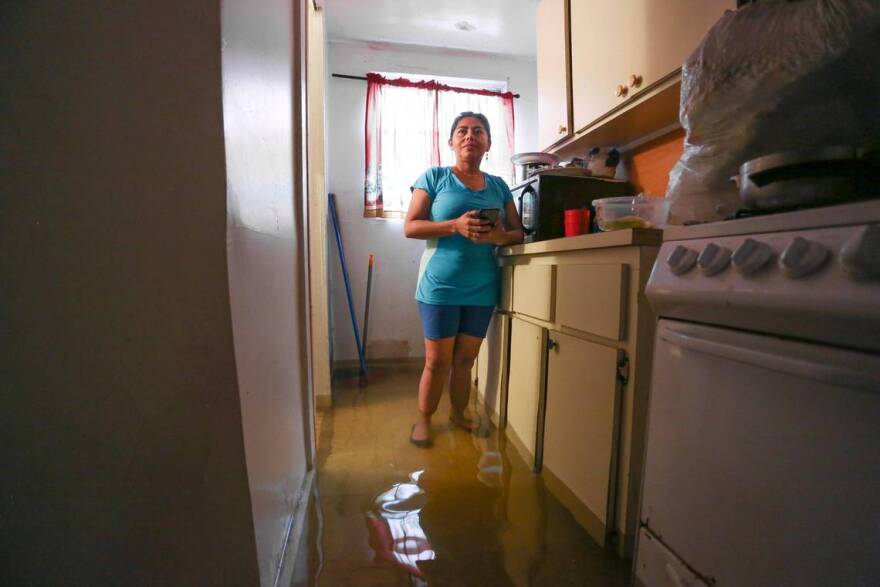Has your house or apartment flooded before? In Florida, good luck finding out
As an unnamed storm drenched Miami-Dade earlier this month, some people were shocked to find themselves suddenly sloshing through floodwaters creeping into homes or apartments.
Should they have been warned about flood risks? Had it happened there before?
Finding the answer to the flood history of real estate in Florida is more difficult than in most other states. Government agencies don’t track flooding at the neighborhood and street level — at least in ways easily accessible to the public — and there’s no law requiring home sellers or landlords to tell new residents about damage from past floods.
It’s a longstanding problem pitting consumer advocates against real estate interests, one that the Biden administration recently proposed addressing with a new nationwide standard that would require every seller to inform buyers of past floods.
If it passes, it would affect the futures of plenty of South Florida homes newly flooded by this month’s storm.
It’s hard to say how many homes flooded countywide during the deluge, but some spots, like Elizabeth Astacio’s Little Havana neighborhood, were hit hard. At least six homes on her street saw flooding, some with residents who never dreamed they were at risk until the water seeped under the door.
Astacio, 36, had seen the street and yard in front of her apartment fill with rain before, but she was shocked when floodwaters started to pour into the apartment she’s rented for the last three years. As she frantically tried to rescue her belongings from the encroaching water, which also sent black water spewing out of her bathtub and toilet, she thought about how badly she’d like to move somewhere that this would never happen again.
“Right now in the economic situation we are in we can’t,” she said. “But we are thinking of moving and leaving here.”
If Astacio does move, she won’t have many options for discovering if the new place floods — especially as a renter, like about 40% of the residents in the Miami, Fort Lauderdale, West Palm Beach metro area.
How to find flood spots
The source with the most information on flooding is the Federal Emergency Management Agency. It uses decades of flood information to make maps of flood zones. Properties inside those zones are required to have flood insurance if they have a mortgage. Outside of those zones, it’s voluntary.
But those maps don’t show the whole picture. They’re based on historical data and don’t account for every type of flooding. It’s not uncommon for homes outside a flood zone to get deluged.
The federal government, as well as counties and cities, have a list of properties that have flooded over and over again, so often that the government wants them demolished or rebuilt to higher standards. But it doesn’t release that publicly due to concerns it will cripple property values. Miami-Dade has about 100 of those properties, as of a 2017 count. But that’s likely an undercount as some owners simply don’t report repeated flooding to FEMA, fearful that it will devalue property or force them to do expensive reconstruction.
Daniel A. Varela
/
Miami Herald
After a storm, no one in Miami-Dade comprehensively maps all flooding hot spots across the county. The National Weather Service catalogs some confirmed flash flooding incidents and the county maps its 311 street flooding complaints, but only for the city of Miami and unincorporated Miami-Dade County. Miami also pays a service called ISeeChange to collect posts from residents about flood levels and damage; they logged 111 new posts about the storm.
To fill the information gap, research groups like First Street Foundation have recently popped up to rank individual properties on a 1 to 10 “Floodfactor” scale, and they’ve even worked with Realtor.com to have the results show for every property.
But that information is based on computer modeling and doesn’t have the real-world flood data that governments have, so it’s not the most accurate picture.
The answer, some experts say, is to require sellers to tell buyers about their flood history. The Biden administration recently proposed a nationwide standard for flood disclosure, part of a sweeping package to fix the country’s broken flood insurance program that discounts policies in dangerous, flood-prone areas like Florida’s coast.
Some construction and real estate interests oppose the measure. The National Association of Homebuilders pushed back, for instance, arguing against releasing information on past floods, the cost of flood insurance, “or any other details” beyond whether or not a property is in a flood zone.
Others, including the federally backed company that holds a majority of American mortgages, Fannie Mae, and property insurance companies, are all for it. Experts say the information could help steer people away from flood-prone areas. Those risks will only rise with South Florida expected to see two feet of sea level rise in the next few decades.
“We shouldn’t intentionally keep people in the dark and say that’s good public policy,” said Joel Scata, a water and climate attorney with the Natural Resources Defense Council. “But at the same time, we should not also be hurting people that were red-lined into these flood zone areas or weren’t told about their flood risk in the first place.”
A patchwork of flood disclosure
In Florida, unlike 29 other states, there’s no law forcing buyers to tell sellers about past flood history. Florida mandates that sellers tell buyers about the possibility of lead paint in the home or sinkholes on the property, but not if they have flooded or could flood.
A bill proposing mandatory flood disclosure died in 2020, and no similar bills have been filed since then.
There’s a voluntary flood disclosure form sellers can use, and if they lie on that form or fail to disclose anything important about the property, like flooding, buyers can sue them.
That was the case for a Palm Beach County woman in 2019, Heather Gaker. She sued after discovering her newly purchased (and newly flooded) home had flooded multiple times in the past, despite the voluntary flood disclosure form that said it hadn’t. That final flood tipped Gaker, unwittingly, into the government’s severe repetitive flood loss program. She had to demolish and rebuild her home at a higher elevation.
She eventually won her lawsuit but didn’t collect much cash. The couple who sold her the home immediately filed for bankruptcy and the real estate company didn’t pay up either. She had an undisclosed settlement with the real estate agent.
In states like Texas, Gaker would have been informed about past flooding before buying — a protection that also extends to renters. Landlords there must provide renters a separate form with their lease that spells out whether a property is in a flood plain and if it has a history of flooding. If they fail to do so, the tenant can break the lease, and the landlord is liable for any personal belongings damaged in a flood.
Dan Mathis, a policy fellow with Next100, called this a “huge step” in protecting renters from floods. In a report on flood disclosure for renters, he found only seven states have similar laws. New York passed a rental flood disclosure law that’s awaiting the governor’s signature.

Sam Navarro
/
Special for the Miami Herald
In his report, Mathis found states like Texas and New York usually passed flood disclosure bills after a huge flood event like Hurricane Harvey or Tropical Storm Ida. That’s not happened in Florida.
“Why wait for the next disaster to enact this sort of legislation?” he said. “It’s a small lift, honestly, and the big picture there is everyone should be armed with information on the risks affecting their homes. Disclosure is an easy tool to reduce some of that risk and prepare folks.”
Miami-Dade protections
Miami-Dade County, unlike the state, does require some level of flood disclosure, but it’s got holes. Sellers must include a bold and all-caps note on the contract letting a buyer know if a property is inside a FEMA flood zone and the federal government could require that it be elevated if “substantial improvements” were made to the structure.
It largely does what mortgage lenders already do. They require any buyer in a flood zone to take out flood insurance. The county policy also doesn’t require sellers to mention any history of past flooding or flood claims on insurance. Some counties do, like Leon, home to the state capital of Tallahassee.

Sam Navarro
/
Special for the Miami Herald
Leon County’s flood disclosure ordinance requires property owners to inform both buyers — and renters — in writing if a property has experienced flooding or is flood-prone.
Miami-Dade’s policy is also limited in scope. It only applies to properties sold in unincorporated Miami-Dade, and it leaves out renters like Alba Nubia Flores and, in fact, all of Little Havana or any other Miami neighborhood.
Nubia Flores, 44, had to miss work to spend the day cleaning up the foot of flood water in the Little Havana rental she shares with her son. The water claimed her couch, her bed and swelled the particle board shelf holding most of her stuff.
A few days later, when the neighborhood was still soggy, her landlord came to collect the rent. He offered no help for the damage, the second time in two years heavy rains had come inside the small apartment and ruined Nubia Flores’ belongings.
“He offered nothing,” she said.

Sam Navarro
/
Special for the Miami Herald



.jpg)